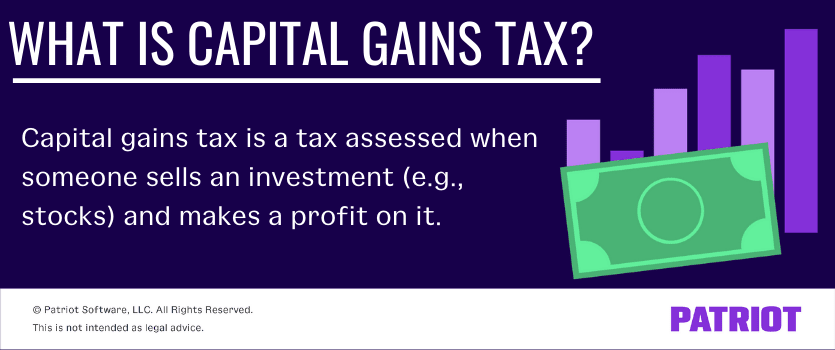Paying tax on your company’s incoming money is all part of being a business owner. But, not all money is taxed the same. If you earn money selling investments, capital gains tax comes into play. Read on to learn what is capital gains tax and why it matters in business.
What is capital gains tax?
Before going over business capital gains tax, you need to know about capital gains and losses. Both are assessed on investments (i.e., assets) that have different values at the point of purchase and the point of sale.
Here’s the breakdown between gains and losses:
- Capital gains: When you sell an asset with a value greater than what you paid for it
- Capital losses: When you sell an asset with a value less than what you paid for it
If you have a gain, you have a capital gains tax. Capital gains tax is a tax someone incurs when they sell an investment and make a profit on it. The tax is on the difference between the price you sell the investment for and what you bought it for. This tax only applies when you sell the investment, not when you own it.

Unlike capital gains, capital losses can earn you a tax deduction. Both individuals and companies can incur capital gains and losses. And, there are a number of exceptions to the tax (which we’ll get to later).
You can have capital gains or losses on any asset you sell, including:
- Stocks
- Cryptocurrency
- Businesses
This means you could owe capital gains tax on stocks, real estate, and any other asset else you sell.
Keep in mind that many assets, such as a car, depreciate (aka lose value due to normal wear and tear) over time. And if your asset depreciates, you do not have a capital gain.
Capital gains and losses vs. operating profits and losses
Any time your business earns or loses money, you need to report it. The difference between different types of profits and losses depends on how you’re earning and losing the money. This is why you record capital gains and losses differently than operating profits and losses.
Whereas a capital gain results from a single sale of an asset, operating profits come from your business’s day-to-day operations.
How much is capital gains tax?
So, what is the capital gains tax rate? To figure out what the rate you’ll be taxed at is, understand the difference between short-term and long-term capital gains.
Short-term capital gains are assets you buy and sell within a year. Short-term capital gains tax is generally the same as regular income (e.g., wages). These taxes are typically higher than the long-term taxes.
Long-term capital gains are assets you hold onto for more than a year. Long-term capital gains tax is 0%, 15%, or 20%. Your rate depends on your tax bracket. Keep in mind that your federal capital gains tax rate does not cover state capital gains tax.
Whether you pay 0%, 15%, or 20% for the capital gains tax rate depends on your:
- Income
- Marital status
Here’s a look at the long-term capital gains tax rate 2021 (based on income and marital status):
| Filing Status | 0% | 15% | 20% |
|---|---|---|---|
| Single | $40,400 and below | $40,401 – $445,850 | $445,850+ |
| Married Filing Jointly | $80,800 and below | $80,801 – $501,600 | $501,600+ |
| Married Filing Separately | $40,400 and below | $40,401 – $250,800 | $250,800+ |
| Head of Household | $54,100 and below | $54,101 – $473,750 | $473,750+ |
You might owe an additional tax on gains if your modified adjusted gross income is above a certain threshold. This additional Net Investment Income Tax (NIIT) is 3.8%. Pay NIIT in addition to your regular capital gains tax rate if you make more than:
- $200,000 (Single or head of household with qualifying person)
- $250,000 (Married filing jointly or qualifying widow(er) with dependent)
- $125,000 (Married filing separately)
Heads up! Higher-income individuals may owe a higher tax on long-term capital gains if President Biden’s tax increase proposal goes into effect. If you earn $1 million or more, your tax rate would increase from 20% to 39.6%, not including the 3.8% NIIT.
Managing and reporting your capital gains
When it comes to managing your capital gains and losses, here are a few strategies you can take:
- Offset capital gains with losses to lower your tax bill
- Roll over capital losses to the next tax year
- Don’t sell an investment for a loss for a tax benefit and turn around and repurchase it
- Time investment sales for better tax rates (i.e., short-term vs. long-term capital gains tax)
- Keep records detailing the price of the investment at the time of purchase and sale in your accounting books
After selling an investment, you must report it to the IRS (and your state). Generally, you must report gains and losses on a few forms and attach them to your tax return. These forms include:
- Form 8949, Sales and Other Dispositions of Capital Assets
- Schedule D (Form 1040), Capital Gains and Losses
So, when do you pay capital gains tax? In some situations, you may have to make estimated tax payments on a taxable gain. Pay estimated taxes quarterly. Consult the IRS for more information.
Recordkeeping is at the heart of every successful business. If you’re looking for a better way to keep your accounting records organized, try Patriot’s online accounting software. Our accounting features are easy to use, so you won’t need to spend a weekend on training. Try it for free today!
This is not intended as legal advice; for more information, please click here.


